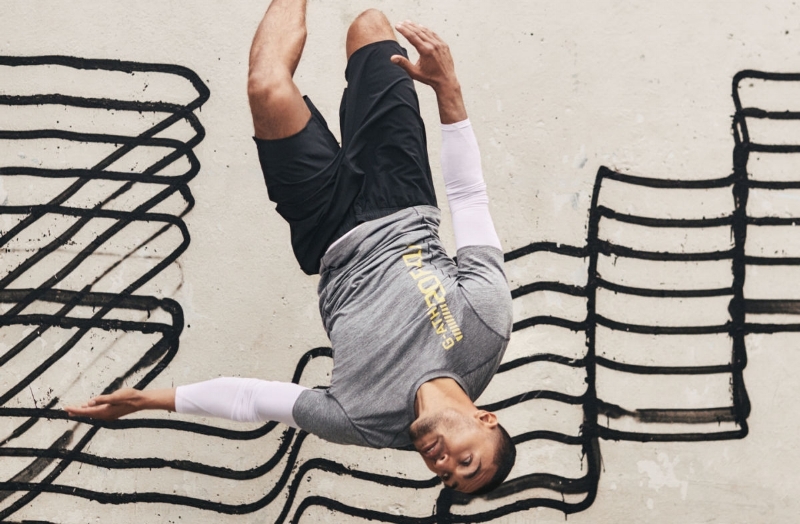 image: H&M
image: H&M
One of the street artists that took Roberto Cavalli to court in August 2014 for allegedly copying his artwork, decided to take on H&M and the matter might give rise to much-needed answers in the fight to protect graffiti. According to H&M’s newly-filed lawsuit, Jason “Revok” Williams, a famous Los Angeles-based graffiti artist, sent H&M a cease and desist letter, alleging that the Swedish fast fashion giant had “included [his] original artwork in an advertising campaign for H&M products without his permission or knowledge.”
In the letter, dated January 8, 2018, Williams’ counsel demanded that H&M “‘immediately cease’ use of [its] New Routine advertising campaign containing images of the graffiti painted by Mr. Williams.” According to the letter, H&M used a photo a model in front of a handball court in Williamsburg, Brooklyn in a video posted to its website to promote its recently-released men’s sportswear called New Routine. Turns out, the handball court wall was covered with Williams’ graffiti (pictured below).

The Art of “Vandalism”?
Instead of ceasing its use of the imagery, H&M is fighting back. The retailer responded to Williams’ letter with a lawsuit, asking a federal court in Brooklyn on Friday to declare that it is not on the hook for copyright law or unfair competition because, for one thing … Williams’ work “was unauthorized and constitutes vandalism,” and is, thereby, not protected by copyright law.
According to H&M’s suit, right around the time that the New Routine campaign was shot, the production company it hired reached out to the New York City Department of Parks and Recreation (“DPR”) to determine “whether it needs to pay royalties for use of the graffiti images as part of the H&M shoot.” The fast fashion giant alleges that a representative for DPR responded to the inquiry and stated, “The graffiti should NOT have been on the hand ball wall. Whom ever placed this on the wall caused me to fail this feature when inspected last week. I am unaware who did this.”
Due to Williams’ “commission of illegal acts in connection with the graffiti, including criminal trespass and vandalism to New York City property, he does not own or hold any valid or enforceable copyright rights in the graffiti,” H&M argues in its complaint.
Copyright law, if applicable, gives the creator of an original artwork the exclusive right to reproduce and display the work, i.e., in photos. But H&M argues in the case at hand, just as Jeremy Scott and Moschino argued in a graffiti case in 2016, that when street art is the result of vandalism and/or trespass, it is not afforded copyright protection.
Is that true? Maybe … but also maybe not. While copyright infringement cases that center on unauthorized graffiti are almost always either settled out of court or amount to a losing battle for the artists, it is worth noting that the bar for obtaining copyright is very low. A work need only be: Original and composed in a fixed medium. Nowhere in the Copyright Act does it expressly state that illegality is a bar to copyrightability.
Still yet, in a handful of the settled-or-unsuccessful cases involving graffiti that we have seen (in one unsuccessful case, the 9th Circuit held that Green Day’s use of another’s graffiti in one of its videos constituted fair use because the graffiti appeared for such a short time in the background) many courts have considered (although not issued a ruling) graffiti within the realm of copyright law rather than merely tossing it aside due to the illegality factor.
On the flipside, no shortage of scholars have argued that illegal works are not copyrightable because they fail to “promote the progress of science and useful arts,” as set forth in the U.S. Constitution.
As a result of the lack of a bright line rule in terms of whether unauthorized graffiti (as opposed to commission street art) is – or is not – protected by copyright law, this case could prove to be a particularly interesting one … if the parties do not follow the larger practice of settling out of court, before trial, that is.
UPDATED (March 15, 2018): According to a statement from H&M, “H&M respects the creativity and uniqueness of artists, no matter the medium. We should have acted differently in our approach to this matter. It was never our intention to set a precedent concerning public art or to influence the debate on the legality of street art. As a result, we are withdrawing the complaint filed in court. We are currently reaching out directly to the artist in question to come up with a solution. We thank everyone for their comments and concerns, as always, all voices matter to us.”
*The case is H&M Hennes & Mauritz GBC AB, and H&M Hennes & Mauritz L.P., v. Jason Williams a/k/a Revok, 1:18-cv-01490 (EDNY).










